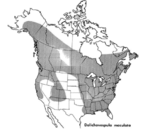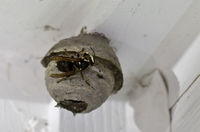Dolichovespula: Difference between revisions
| Line 25: | Line 25: | ||
|thumb]] | |thumb]] | ||
''Dolichovespula maculate'' is a social wasp of the family [Vespidae]. Its common names include the bald-faced hornet, white-faced hornet, bald hornet, black jacket, and bull wasp. This is actually a species of yellow jacket wasp and not a true hornet [1]. It is one of eight major members from the genus ''Dolichovespula'' in North America. It can be found in most of the lower 48 states and throughout Canada and Alaska. It is found mostly in forested areas or in vegetation in urban areas. Nests are generally located in trees and bushes, but can occasionally be found under rock overhangs and on the sides of buildings. | ''Dolichovespula maculate'' is a social wasp of the family [Vespidae|https://en.wikipedia.org/wiki/Vespidae]. Its common names include the bald-faced hornet, white-faced hornet, bald hornet, black jacket, and bull wasp. This is actually a species of yellow jacket wasp and not a true hornet [1]. It is one of eight major members from the genus ''Dolichovespula'' in North America. It can be found in most of the lower 48 states and throughout Canada and Alaska. It is found mostly in forested areas or in vegetation in urban areas. Nests are generally located in trees and bushes, but can occasionally be found under rock overhangs and on the sides of buildings. | ||
==''' Behavior and Colonization '''== | ==''' Behavior and Colonization '''== | ||
Revision as of 17:02, 5 May 2019
Classification

Kingdom: Animalia
Phylum: Arthropoda
Class: Insecta
Order: Hymenoptera
Family: Vespidae
Genus: Dolichovespula
Species: D. maculata
Overview

Dolichovespula maculate is a social wasp of the family [Vespidae|https://en.wikipedia.org/wiki/Vespidae]. Its common names include the bald-faced hornet, white-faced hornet, bald hornet, black jacket, and bull wasp. This is actually a species of yellow jacket wasp and not a true hornet [1]. It is one of eight major members from the genus Dolichovespula in North America. It can be found in most of the lower 48 states and throughout Canada and Alaska. It is found mostly in forested areas or in vegetation in urban areas. Nests are generally located in trees and bushes, but can occasionally be found under rock overhangs and on the sides of buildings.
Behavior and Colonization

These hornets are omnivorous and will feed on a wide variety of live prey and plant materials. Live meals will be returned to the nest where they are chewed up and fed to young hornets. [3] Workers will feed on nectar, tree sap and fruit pulp, their favorite being the flesh of apples. [6] They are generally considered useful by humans due to their predation of pests such as flies, spiders, caterpillars, etc. on the other hand, they will vigorously defend the nest from anything that comes to close. Workers can sting repeatedly and even have the ability to spray venom from their stinger to ward off vertebrate next intruders. [4] In the spring, fertilized queens that have overwintered in sheltered areas such as in hollow trees, rock piles, under logs, and in buildings, will become active and begin to build a nest. [1] Once a nest is formed, the queen will lay an initial brood of eggs which hatch and take over the role of growing the nest and feeding future generations. Colonies will average a count of 400 individuals but can range from 100 – 700. In the fall , October and early November, newly created and fertilized queens will find a spot to overwinter and the rest of the colony will die off.
Importance In Soil

The nest that the hornets form is made from cellulose from rotting and weathered wood and starch from the hornet’s saliva to from a water resistant papery substance. This action of scouring for degraded wood makes them part of the soil decomposition cycle. They also play a role in moving energy up the food chain through feeding and providing energy for other life when all of the colony, besides the fertilized queen, die off in the fall. These nests also provide a nutrition for parasites that require the nest as a food source. Female Bee Moths (Aphomia sociella) have been known to lay eggs in hornet nests. The hatched larvae will then proceed to feed on the eggs, larvae, and pupae left unprotected by the wasps, sometimes destroying large sections as they tunnel throughout the nest looking for food. [5]
References
[1] Jacobs, Steve. “Baldfaced Hornet (Department of Entomology).” Department of Entomology (Penn State University), 2015, ento.psu.edu/extension/factsheets/baldfaced-hornet. https://ento.psu.edu/extension/factsheets/baldfaced-hornet
[2] “Dolichovespula Maculata, Distribution.” Dolichovespula Maculata, Distribution Image, www.discoverlife.org/mp/20p?see=I_SD4398&res=640. https://www.discoverlife.org/mp/20p?see=I_SD4398&res=640
[3] Heinrich, B. J. J. o. C. P. B. 1984. Strategies of thermoregulation and foraging in two vespid wasps, Dolichovespula maculata andVespula vulgaris. 154:175-180. https://link.springer.com/article/10.1007/BF00684142
[4] Oswalt, Donald A, and Patricia A Zungoli. “Baldfaced Hornets.” Home & Garden Information Center | Clemson University, South Carolina, hgic.clemson.edu/factsheet/baldfaced-hornets/. https://hgic.clemson.edu/factsheet/baldfaced-hornets/
[5] Gambino, P. J. J. o. t. N. Y. E. S. 1995. Dolichovespula (Hymenoptera: Vespidae), hosts of Aphomia sociella (L.)(Lepidoptera: Pyralidae).165-169. https://www.jstor.org/stable/25010152?seq=1#page_scan_tab_contents
[6] “Dolichovespula Maculata.” Bio 210 Vespula Maculata, bioweb.uwlax.edu/bio210/s2012/bollinge_seth/nutrition.htm. http://bioweb.uwlax.edu/bio210/s2012/bollinge_seth/nutrition.htm
[7] “Georgia Department of Agriculture.” Baldfaced Hornets - Ga Dept of Agriculture, agr.georgia.gov/baldfaced-hornets.aspx. http://agr.georgia.gov/baldfaced-hornets.aspx
[8] Holland, Mary. “Bald-Faced Hornet Nests No Longer Inhabited (If You Live Where There Has Been a Hard Frost).” Naturally Curious with Mary Holland, 3 Nov. 2015, naturallycuriouswithmaryholland.wordpress.com/2015/11/03/bald-faced-hornet-nests-no-longer-inhabited-if-you-live-where-there-has-been-a-hard-frost/. https://naturallycuriouswithmaryholland.wordpress.com/2015/11/03/bald-faced-hornet-nests-no-longer-inhabited-if-you-live-where-there-has-been-a-hard-frost/
[9] “Bald-Faced Hornet, Queen - Dolichovespula Maculata - a Photo on Flickriver.” Flickriver, www.flickriver.com/photos/maximillian_millipede/3558361392/. https://www.flickriver.com/photos/maximillian_millipede/3558361392/